December 2, 2022
Air Date: December 2, 2022
FULL SHOW
SEGMENTS
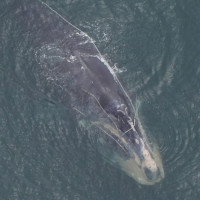
Lobster Industry on the Hook to Save Right Whales
View the page for this story
Entanglement in fishing gear for crab and lobster traps is one of the biggest threats to the critically endangered North Atlantic Right Whale. So, the Marine Stewardship Council recently suspended its sustainability certificate for the lobster fishery in the Gulf of Maine, which led Whole Foods to halt its sale of Maine lobsters. Nicole Ogrysko, Bangor News Correspondent for Maine Public Radio, joins Host Bobby Bascomb to discuss the impacts to Maine lobstermen who are already struggling with high fuel prices, volatile lobster prices and the trade war with China. (10:33)
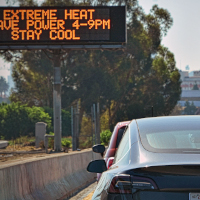
Climate Change and Your Health
View the page for this story
Extreme heat, severe storms, and wildfires are just a few of the impacts of climate change that can harm people, from cardiovascular disease to mental illness. So, healthcare advocates like Dr. Kimberly Humphrey, an emergency physician from Australia and a fellow at Harvard’s Center for Climate, Health, and the Global Environment, are calling for a drastic reduction in fossil fuel use to avoid the worst of the climate crisis. She joins Host Bobby Bascomb to discuss how healthcare can prepare for a climate-changed future and why recent commitments promised at the COP27 climate talks fall short of what’s needed to keep people safe. (10:51)
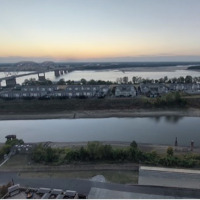
Maybe Like Dust Bowl Days? Low Water on the Mississippi
View the page for this story
Shallow water linked to years of drought has severely limited navigation on the Mississippi River, making it harder for farmers to get their corn, soybeans and wheat to market. Chad Hart is a professor of Agricultural Economics at Iowa State University in Ames and joins Host Steve Curwood to talk about the climate connections with the midwestern drought similar to the Dust Bowl Era and how it’s affecting food commodities. (08:41)
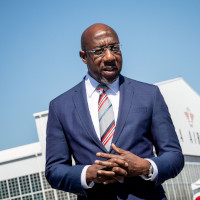
Beyond the Headlines
/ Peter DykstraView the page for this story
Environmental Health News weekend editor Peter Dykstra joins Host Steve Curwood to talk about how environmental voters appear to be turning out for the runoff election in Georgia. Then the two discuss concerns around a twenty-six story pig farming building in the Hubei province of China. And for history they recount the 1873 and 1952 killer fogs in London that killed thousands of people. (04:47)
Battle For the Sepik River
View the page for this story
The Sepik River in Papua New Guinea is interwoven with the physical and spiritual lives of indigenous forest communities. But a plan to build a copper and gold mine along a tributary threatens the river and the 400,000 people living along it. Emmanuel “Manu” Peni, the coordinator of Project Sepik, tells Host Bobby Bascomb about his community’s fight against the mining plan and efforts to keep Papua New Guinea’s longest river clean. (11:26)
Listening on Earth
/ Bobby BascombView the page for this story
The World Cup soccer games are in full swing in Qatar and around the world fans are tuning in to cheer on their country’s team. At the Cloud Forest School in Monteverde, Costa Rica school stopped mid-morning so students could watch Costa Rica play Spain. ()
Show Credits and Funders
Show Transcript
221202 Transcript
HOSTS: Steve Curwood
GUESTS: Chad Hart, Kimberly Humphrey, Nicole Ogrysko, Manu Peni
REPORTERS: Peter Dykstra
[THEME]
CURWOOD: From PRX – this is Living On Earth.
[THEME]
CURWOOD: I’m Steve Curwood.
BASCOMB: And I’m Bobby Bascomb
North Atlantic Right Whales are at risk of extinction from ship strikes and entanglements with fishing gear.
OGRYSKO: So, the Marine Stewardship Council found that its sustainability label for the Maine lobster fishery should be suspended and that triggered Whole Foods to announce that they would stop purchasing lobster from Maine.
CURWOOD: Also, extended La Niña weather conditions are bringing drought to much of the Midwest.
HART: If you go back into the data, we had a stretch in the early 1970s where we saw this but the one that I'd say most people think is, if you will, the parallel to this one would be the Dust Bowl era that we saw in the 1930s.
CURWOOD: That and more this week on Living on Earth – Stick Around!
[NEWSBREAK MUSIC: Boards Of Canada “Zoetrope” from “In A Beautiful Place Out In The Country” (Warp Records 2000)]
[THEME]
Lobster Industry on the Hook to Save Right Whales
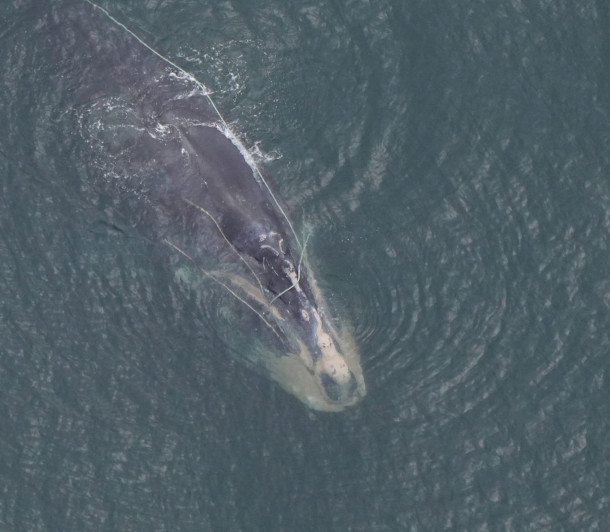
Only around 350 North Atlantic right whales remain in the wild. The primary known causes of death for these marine mammals are ship strikes and rope entanglements. (Photo: New England Aquarium, taken under NOAA permit #25739)
CURWOOD: From PRX and the Jennifer and Ted Stanley Studios at the University of Massachusetts Boston, this is Living on Earth. I’m Steve Curwood.
BASCOMB: And I’m Bobby Bascomb.
Less than 350 North Atlantic Right Whales remain, and biologists warn that extinction of the species is a very real possibility. The main threats to the whales are ship strikes and entanglement in fixed fishing gear like that for crab and lobster traps. The traps sit on the sea floor and are connected to a surface buoy by long vertical ropes. Migrating whales swim through the ropes and can get them tangled around their fins and bodies, cutting into their skin and weighing the whales down making it impossible to adequately feed themselves and reproduce. NOAA Fisheries estimates roughly 85 percent of right whales have been entangled in fishing gear at least once. Northern Right Whales migrate from as far south as Florida up the east coast to New England and the coast of Canada. They may encounter hazards from fishing gear anywhere along that journey. A federal court case to address those dangers, recently prompted the Marine Stewardship Council to suspend its sustainability certificate for the lobster fishery in the Gulf of Maine. In response, Whole Foods has paused its sale of Maine lobsters, a blow to Maine lobstermen who are already struggling with high fuel prices, volatile lobster prices and the trade war with China. For more, I’m joined now by Nicole Ogrysko, Bangor News Correspondent for Maine Public Radio. Nicole, welcome to Living on Earth!
OGRYSKO: Thanks for having me.
BASCOMB: So how does lobster gear potentially entangle right whales? What is the conflict there to begin with?
OGRYSKO: So, federal scientists have found that entanglements and ship strikes are the two biggest causes of injury to the North Atlantic right whale population. And so on the entanglement side, when a fisherman drops their trap into the water, that long length of rope could become entangled with a whale. And it should be noted, I mean, the numbers seem to vary on this, but the latest data that I've seen mentions anywhere from 340 to 350 of these whales that exist at this point, although that's constantly changing. And so any entanglement is worrisome to those who are watching this population and are attempting to restore the population.
BASCOMB: So tell us please about the Marine Stewardship rating for Maine lobster and how that impacted the decision from Whole Foods to drop Maine lobster.
OGRYSKO: So the Marine Stewardship Council based its decision on a federal court ruling back in July that found that existing regulations from the National Oceanic and Atmospheric Administration that were designed to reduce the risk of the Maine lobster fishery to the North Atlantic right whale population, which is endangered, that those regulations didn't go far enough, and specifically that they didn't comply with the terms of the Marine Mammal Protection Act and the Endangered Species Act. And so they found that in light of that decision, its sustainability label for the Maine lobster fishery should be suspended. And that announcement, I think, is really what triggered Whole Foods to announce that they would stop purchasing lobster from Maine. And that MSC label, that was an international certification. So it's a pretty sweeping announcement that came out recently.
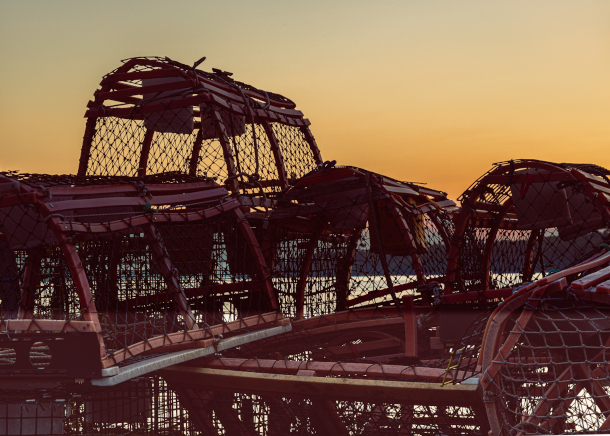
Whales can become entangled with the long vertical rope that attaches a lobster trap to its buoy. (Photo: Rob Kleine, Flickr, CC BY-NC 2.0)
BASCOMB: And how likely is it that other grocery chains or other buyers might follow suit?
OGRYSKO: I would say it is likely that we could see others follow what Whole Foods did. You know previously this year, a program known as Seafood Watch, which is based out of the Monterey Bay Aquarium, they red-listed lobster out of the United States and Canada essentially encouraging people not to consume it because of similar concerns over the fisheries' risk to right whales. So I think it's possible that we might see more sustainability certification suspensions like this and that potentially others like Whole Foods might follow suit.
BASCOMB: Well, what evidence did the court site or the Marine Stewardship Council for that matter, what evidence do they cite for attributing right whale entanglements to Maine lobster gear?
OGRYSKO: Well, so that's what I think is making this ongoing series of events really frustrating for the Maine lobster industry. Because the Marine Stewardship Council noted in its announcement while the court has found the regulations don't go far enough in reducing the risk to right whales, they acknowledge that no evidence was found that the Maine lobster fishery is responsible for entanglements or interactions with right whales. So I think that is why we're seeing the frustration from the lobster industry, and you know, really public outcry both from lobstermen and the state of Maine and the congressional delegation here in Maine. There's little evidence really tying the problem specifically to the main lobster fishery.

After the Marine Stewardship Council suspended the Maine lobster fishery’s sustainability certification, Whole Foods announced it would suspend sales of the product. (Photo: ABRAS, Flickr, CC BY 2.0)
BASCOMB: Is the gear that these lobstermen are using, are they labeled? I mean, if they're labeled in some way, then that would seem like an obvious way to know for sure what gear is untangling the whales, because we know that they are being entangled. I mean, you can see aerial photographs of a whale swimming along with all of this rope and gear attached to their bodies. So how can we figure out the source of it?
OGRYSKO: I believe there is an effort to label the gear but that effort is ongoing. And so if you talk to environmental groups and sustainability experts, they'll tell you that there's a desire by everyone, really, for more labeling to happen for there to be better tracking of the whales movements. I mean, it's tricky, I think, to define a specific entanglement at this point in time to a specific fishery. And so that is part of the problem.
BASCOMB: Well, the Maine lobster industry has, you know, had its ups and downs over the last few years. There's the pandemic, there was a trade war with China, climate change, the cost of fuel. But this is people's livelihoods. A lot of people make their living support their families from catching and selling lobster. So how is the industry responding to this news from MSC and Whole Foods? How are they looking to move forward?
OGRYSKO: I would say that the response isn't necessarily tied specifically to the Marine Stewardship Council's recent announcement or the announcement from Whole Foods. I think it is more focused on this ongoing debate over federal regulations and some of the court battles that have been happening. You know, the National Marine Fisheries Service out of NOAA is trying to change those federal regulations so they are in compliance with the Marine Mammal Protection Act and the Endangered Species Act. They're trying to solicit feedback from the lobster industry here in Maine, about what they could do, honestly, to further reduce the risk that the fishery poses to the North Atlantic right whale population. And so those conversations have been ongoing, and quite frankly, they haven't necessarily gone very well. A lot of the ideas that the federal government has suggested would impact the lobster industry quite a bit. You know, they're talking about closing more square miles of Maine fishing grounds, implementing trap limits, further changes to their gear, which the lobstermen will tell you will make it more difficult for them to do their jobs essentially.
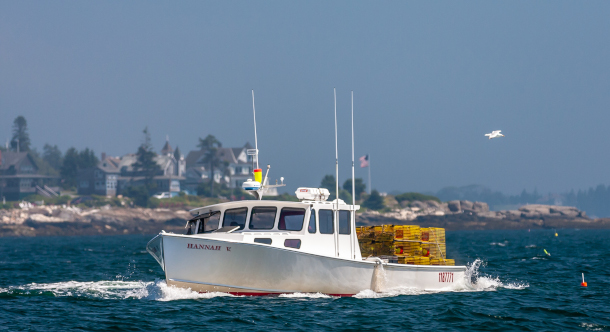
The Marine Stewardship Council noted that it could not specifically tie right whale entanglements to the fishery in Maine– as opposed to other New England fisheries–prompting outcry from the Maine lobstering community. (Photo: Rob Kleine, Flickr, CC BY-NC 2.0)
BASCOMB: So to what extent has the Maine lobster community addressed these issues of you know, right whale entanglements over the years? What steps if any, have been taken to change the way they're fishing to accommodate the whales?
OGRYSKO: So the Maine lobster industry, they were already subject to seasonal closure last year of nearly 1,000 square miles of Maine fishing grounds. Like I mentioned earlier, they have been testing out new gear, specifically ropeless gear. There are other organizations that are doing more research, trying to find new solutions. So, you know, I think the argument from the Maine lobster industry side of things is that they're doing the work and they're following the regulations that are out there. And so they'll tell you that the lobstermen aren't the problem. It's the federal government's problem for not issuing valid regulations. And so again, like I mentioned, there's this ongoing debate over what new regulations should be, and how much regulation is too much, that balances you know, the health of the lobster fishery with the health of this endangered right whale population.
BASCOMB: Do you know what kind of regulations would the fishermen be looking for that they could agree with and would still be, you know, sustainable for their livelihood and sustainable for the whale populations?
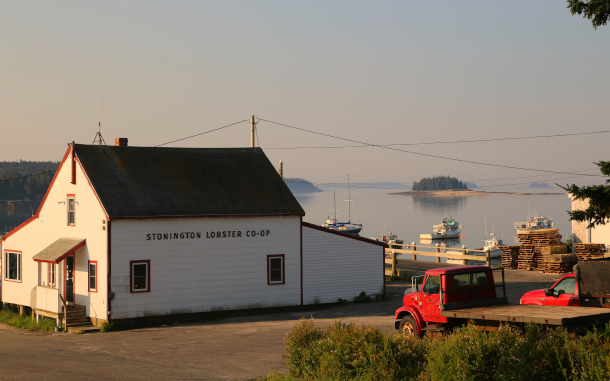
The Maine lobstering community, which has suffered several recent economic blows, argues that federal regulations often go too far, making it impossible for them to maintain their livelihoods. (Photo: JR P, Flickr, CC BY-NC 2.0)
OGRYSKO: I guess I'll point again to you know, some of the testing that has been done on ropeless gear, tagging gear so that entanglements or interactions with right whales can be specifically identified to a specific fishery Maine, for example, or other New England fisheries. You know, the other thing I would mention, and the state of Maine is exploring this and has been pushing for this is some sort of financial relief for the Maine lobster industry. If they're going to have to comply with stricter federal regulations, can there be some sort of financial compensation to help them change their gear adopt new kinds of methods here, or account for the fact that they may have to fish within a smaller region of the Gulf of Maine or that they may have to place fewer traps in general? So I think it kind of remains to be seen what the solution really is here.
BASCOMB: Nicole Ogrysko is a Bangor News Correspondent for Maine Public Radio. Nicole, thank you so much for this time with me today.
OGRYSKO: Yeah, thanks, Bobby, for having me.
Related links:
- Marine Stewardship Council | “Home Page”
- Marine Stewardship Council | “MSC Certification Suspended for Gulf of Maine Lobster Fishery”
- Center for Biological Diversity | “Center for Biological Diversity v Gina Raimondo, Maine Lobstermen’s Association”
- NOAA Fisheries | “North Atlantic Right Whale”
[MUSIC: Rikard From, “Sun of June” on Sun Of June, Rikard From Records]
CURWOOD: Coming up- climate change poses major risks to human health but those threats were largely ignored at the recent UN climate talks. That’s just ahead on Living on Earth.
ANNOUNCER: Support for Living on Earth comes from Sailors for the Sea and Oceana. Helping boaters race clean, sail green and protect the seas they love. More information @sailorsforthesea.org. Support also comes from Friends of Smeagull the Seagull and Smeagull’s Guide to Wildlife. It’s all about the wildlife right next door to you! That’s Smeagull, S - M - E - A - G - U - L - L, SmeagullGuide.org.
[CUTAWAY MUSIC: Rikard From, “Sun of June” on Sun Of June, Rikard From Records]
Climate Change and Your Health
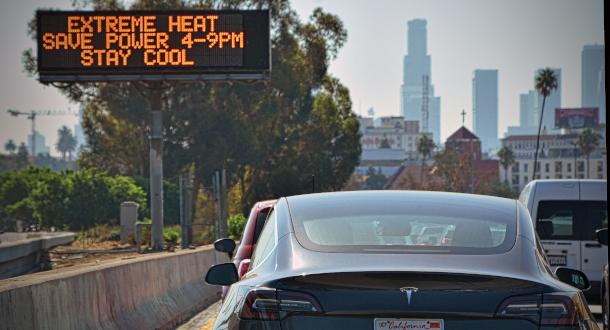
Extreme heat, which will become more common in the future, exacerbates existing health conditions, from kidney disease to mental illness. (Photo: Chris Yarzab, Flickr, CC BY 2.0)
CURWOOD: It’s Living on Earth, I’m Steve Curwood.
BASCOMB: And I’m Bobby Bascomb
Climate disruption poses serious threats to our health. Extreme heat, severe storms, and wildfires are just a few of the impacts of climate change that can harm people, from cardiovascular disease to mental illness. And these challenges are pushing healthcare systems across the world to their limits. In response, a global community of healthcare professionals is calling for a drastic reduction in fossil fuel use to avoid the worst of the climate crisis and at the same time prepare healthcare for a climate-changed future. During COP27, the recent UN treaty talks in Egypt, some countries listened to that plea. The US Department of Health and Human Services and the UK National Health Services announced a partnership designed to decarbonize their supply chain emissions as quickly as possible. But health care advocates like Dr. Kimberly Humphrey say that these measures just aren’t enough. Dr. Humphrey is an emergency physician from Australia and a fellow at Harvard’s Center for Climate, Health, and the Global Environment. She says the relationship between health and climate change should be front and center at any climate talks.
HUMPHREY: So the climate crisis is a health crisis. And climate change impacts every single aspect of our health and well-being. So nine of the 10 warmest years occurred between 2005 and 2019. And that's going to become just the normal for us. So when we think about the health impacts of heat, we do see patients with the obvious impacts of heat that that would come to mind for anybody. So those are things like heat related illness or heat stroke, particularly in older people, those in lower socioeconomic groups who can't afford air conditioning, for example, and those who work outside or who do athletic activity outside. One of the really interesting things, and this is not even appreciated by all people who work in health, almost every medical condition is affected by heat. So we see people who have worsening of their heart disease, of their lung conditions, of their kidney disease, we see more presentations with mental illness when there's significant heat. It has profound effects on medication. So many medications affect the ability of the body to regulate temperature, which makes people more susceptible to heat illness. And some medications like insulin are required to be stored at a lower temperature, and just do not work if they're stored in the heat as well. So there is a lot that intersects climate change and health.

Extreme weather events, such as flooding and hurricanes, can have serious long-term mental health effects on those who experience them. (Photo: Thomas_H_foto, Flickr, CC BY-ND 2.0)
BASCOMB: And you mentioned that the connection isn't even very well understood by people in health care. What do you mean by that?
HUMPHREY: I find it quite astounding how many of my colleagues don't understand the connections between climate change and health. One of the big problems is it isn't really taught in medical school education, for example. But when it is taught, it tends to be just one concentrated focused lecture, for example. What needs to happen is it needs to be integrated into all curriculum. So when we're doing a unit on heart disease, for example, they can be teaching about what climate change effects intersect with heart disease. And it should be taught throughout the curriculum and throughout all of the training for a healthcare professional.
BASCOMB: So how might these climate-related health emergencies that we've been talking about here, how might they affect patients long term? I mean, what kind of physical and even mental health effects are we potentially looking at, you know, down the road?
HUMPHREY: Absolutely. So this is one of those really interesting areas where, in climate change and health, there's an awful lot of research that still needs to be done. And one of the things we don't know is how it will affect people long term, particularly confounding events, where they live in a place where they just keep getting impacts of climate change over and over and over again. We see communities so displaced by flooding or by wildfire, who can't access the usual health care providers. We don't know what that does to the management of their chronic health issues. What we do know is that climate change has impacts on all these chronic health conditions. And it will only make those things worse long term. In regards to mental health, we know that young people today are experiencing eco anxiety and eco grief. We know from a 2020 survey that more than half of Americans reported feeling anxious about climate's impact on their mental health. And more than two-thirds are anxious about how climate change affects the planet. So we have that underlying sort of current of distress around this. And then for people who are impacted by extreme weather events related to climate change, we see things like post-traumatic stress disorder. We see really profound impacts on their mental health. And we know that for every one degree Celsius increase in temperature, there's about a 0.7% rise in suicide in the US as well. So we're seeing impacts that will just continue to escalate as our temperature rises.
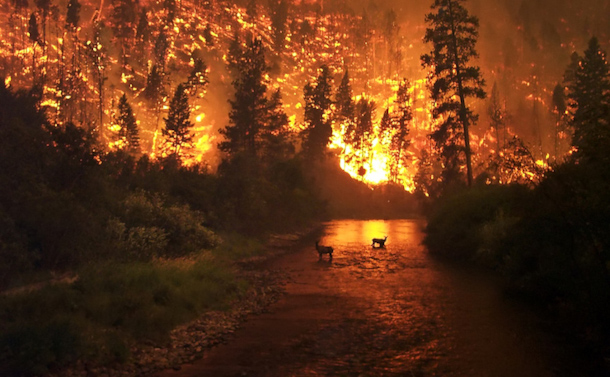
Hospitals need to prepare for extreme weather events that they may have never experienced before, health advocates say. (Photo: Project LM, Flickr, CC BY-NC-ND 2.0)
BASCOMB: So what is our current health care system missing that maybe we should be investing in now?
HUMPHREY: So we did touch on one of those things. And that's the education of the people who work within the healthcare systems. So often, the impacts of climate change are obvious. So there is a hurricane, for example, and someone comes in with broken bones, staff does know how to treat that. What many of our healthcare professionals don't know is the more subtle things. So some of the things I mentioned, like if somebody comes in with a heart attack, for example, on a really, really hot day, not everyone makes the link that that is because of climate change. So you really need to have that education to understand those more subtle things and not just say "heart disease" on a death certificate and actually say it was the climate change that led to this. Equally, we know that populations of mosquitoes, for example, are changing where they live. So we're seeing diseases where we didn't used to see diseases. And if people who work in these new areas don't understand what to look for, they are not going to be able to diagnose people who present with these problems. Then we move to the area of resilience of our healthcare systems, which is something that myself and my colleagues are doing a lot of research and a lot of work on. We know that we aren't prepared as healthcare systems, and I would say across the globe, for the impacts of climate change. So that's things like resilience within communities. So building programs within communities to understand what they need to do when there's a heatwave, what they need to do when there's a hurricane in regards to their health and how to maintain the health of the community and the people within it. We also need to better understand the risks to our healthcare facilities and prepare our healthcare systems to deal with what's coming. So that might be physical infrastructure and making buildings more resilient. It might be even looking at the fact that when there's a fire, for example, people will divert away from a hospital in the area of that fire to another hospital. And we see more significant patient presentations. So it's understanding how we can surge up to meet that as well. And then also understanding the impacts that it has on workforce and infrastructure when there is an extreme weather-related disaster. Blackouts, inability to get medication, all of those kinds of things we need to be thinking about and preparing our healthcare systems for.
BASCOMB: Here in the US during Hurricane Katrina, famously, the hospitals there, the lower part of the hospitals, actually flooded, and were without electricity or air conditioning, and, you know, people died as a result. So it's easy to see, as you're saying, how building resilience into the physical infrastructure is really important.

Decarbonizing the health care system could include addressing transportation, infrastructure, and supply chain emissions. (Photo: Presidencia de la Republica Mexicana, Flickr, CC BY 2.0)
HUMPHREY: Yeah, absolutely. And we know, so in certain areas, there's always been fires, for example, and we know healthcare systems in those areas might be very well equipped to deal with fires, because they understand it, and they're used to it. What a lot of healthcare systems haven't done or need to do better is assess their vulnerabilities and have a look at how the impacts might change, what might come and what might affect them that they've never experienced before. So we have recently seen that in Australia, where there has been really significant flooding affecting communities that have not seen that before, and who weren't prepared for the impact. So it's firstly doing that really good risk assessment, and then preparing our systems to deal with it.
BASCOMB: Well, can you talk a bit please about the carbon footprint of the healthcare system itself? What needs to change there? You know, we've been talking about the climate crisis as a concern for health. But I think the healthcare industry is also contributing to that very problem.
HUMPHREY: So we know that healthcare systems across the globe, if they were a country, they would be the fifth largest emitter of carbon emissions, which is incredibly significant. So it's things like infrastructure: It's how we power our buildings to begin with, it's all the transport associated with buildings. It's the food associated with our hospitals and healthcare systems as well. There's also a significant digital footprint from all of the technology that we use. And then there's the concept of high carbon low value care, which is a significant issue that clinicians can really address. And that's things like surgeries, radiology, like MRIs or CT scans, that a patient does not need to improve their healthcare journey, and really has a significant carbon footprint. We have everything associated with the pharmaceuticals, the supply chains, and things that go into our hospitals. And then there's things like anesthetic gases. There is a lot that we can be doing that we're not doing to decarbonize our healthcare system.
BASCOMB: How has climate change and health been addressed at previous COP meetings, if at all?
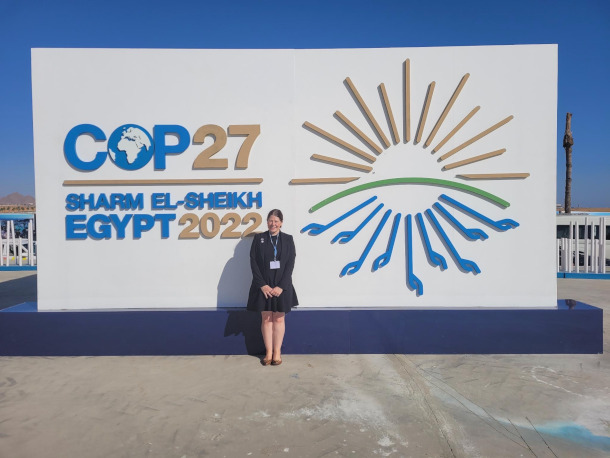
Our guest, Dr. Kimberly Humphrey, says that health remained secondary at the COP27 talks, despite its intersection with climate change. (Photo: Courtesy of Dr. Kimberly Humphrey)
HUMPHREY: Absolutely. So it might be astounding to hear, but COP26, which was last year, was the first year to have a health program. So it's really not been on the agenda. And when I was at COP, I spoke to a number of people who were in other sectors, so they might be in sort of economics or infrastructure or high-level people, who said to me, “What does climate change have to do with health? Why are you here?” which is astounding because the intersection is so strong. So now we're in the second year of the COP26 Health Program, which has been repurposed to be called the Alliance on Transformative Action on Climate and Health. What this is now is a program to support governments in high- and low-middle income countries to support and model the implementation of net-zero climate resilient health systems. So financing the health commitments for these climate resilient and sustainable low carbon healthcare systems. But it still tends to be to the side of the main negotiations. So as well as that there's quite a dedicated team of health professionals on the ground at COP who worked really hard to insert action based language centered around health. Climate change is the biggest threat to our health, but it's also our greatest opportunity as well, these very high-level global negotiations to really get that health wording there where it needs to be.
BASCOMB: Dr. Kimberly Humphrey is a Climate Change and Human Health Fellow at Harvard Center for Climate Health and the Global Environment and an emergency physician from Australia. Dr. Humphrey, thank you so much for your time today.
HUMPHREY: Thank you.
Related links:
- UNFCC | “Alliance for Transformative Action on Climate and Health”
- Living on Earth | “Pregnancy and Heat Waves”
- Living on Earth | “Climate Anxiety Therapy”
- Living on Earth | “Warming Climate and Children”s Health”
- Living on Earth | “Bad Air Polluting Our Brains”
[MUSIC: Yellowjackets, “Resiliance” on Parallel Motion, Mack Avenue Records II]
Maybe Like Dust Bowl Days? Low Water on the Mississippi
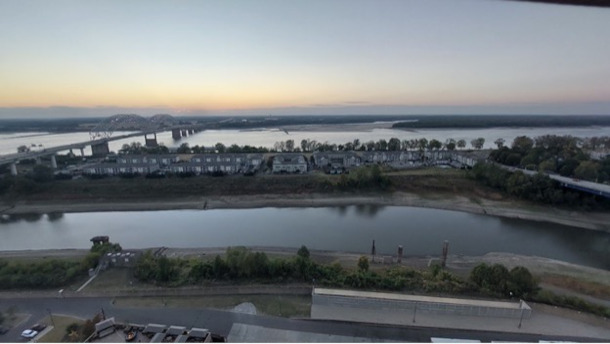
The Mississippi’s reduced volume is evident in the sandbars on either side of this stretch of the river in Memphis. Water levels in some parts of the river have dropped to record lows. (Photo: Courtesy of Kharisher Kahfi)
CURWOOD: Climate disruption is being blamed at least in part for a traffic jam. But in this case, it’s not cars and trucks that are backed up but the massive barge traffic on America’s biggest waterway, the Mississippi River. US commodity crops of corn, soybeans and wheat are a $100-billion business, and nearly 80 percent of US global exports of feed grains and soybeans are produced in the Mississippi Basin. This fall and early winter shallow water linked to years of drought has severely limited navigation and that means barges carrying corn and soybeans produced this year in the Midwest are taking much longer to thread their way past the shoals and sandbars to the port of New Orleans. Farmers are getting 10 or even 20 percent less per bushel for corn and soybeans when they do finally get their crops loaded on a barge, while the export buyers are paying much higher prices for the limited supplies that do make it downriver. Wheat is also affected, but less so as much is milled into flour close to where it’s grown. But problems linked to the Mississippi don’t end at the export docks. And as climate change continues to exacerbate drought conditions around the world, the barge backup along the Mississippi River also affects international food markets. For more I’m joined by Chad Hart. He’s a professor of agricultural economics at Iowa State University in Ames. Welcome to Living on Earth!
HART: It's my pleasure to be with you today.
CURWOOD: Now over half of the Mississippi River is having some kind of drought. Of course with less water, the barge system that transports a lot of goods, particularly I'm thinking of the corn and soy and some of the wheat is having some problems, just how important is the Mississippi River to getting U.S. crops from the fields to where it needs to go?
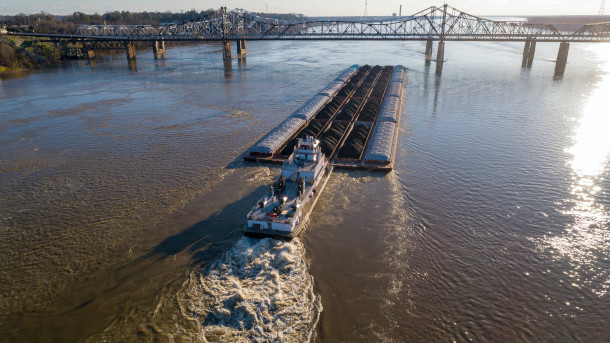
A tugboat pushes barges down the Mississippi River near Vicksburg, Mississippi. (Photo: Justin Wilkens on Unsplash)
HART: It is critically important because when you think about the crops that we grow here in the upper Midwest, anywhere from, you know, my home state of Missouri, through Iowa, Illinois, Indiana, even Minnesota, the Dakotas, a lot of that crop is sent down the Mississippi River to reach especially our international export markets. So when you think about our corn, soybeans, and wheat production, we create a lot of excess production here within the U.S., meaning that domestic demand is not enough to eat through all of that crop. So we do ship tremendous amounts of our crops to the rest of the world. And the Mississippi River is the main conduit to move our product from the interior of the country, out to the border where we can then reach those other markets.
CURWOOD: Of course, the Mississippi has more water and less water at certain times. How big is this drought? Just how much has the Mississippi during the shipping season shriveled up compared to what usually happens?
HART: Well, when we look right now yet, yeah, you're right, there is a seasonality to the level that we see within the river. And right now tends to be one of those times where we do see our lower levels within the year. But what we're seeing right now is historically low. The best way I can describe it is, you know, we're starting to see artifacts that haven't surfaced literally within the last 150 years that are now brought to the surface because the water levels have dropped so far.
CURWOOD: I mean, farming, of course, is always an uncertain business. And there's variability but this sounds like extreme variability. To what extent is this related to climate disruption, do you think?
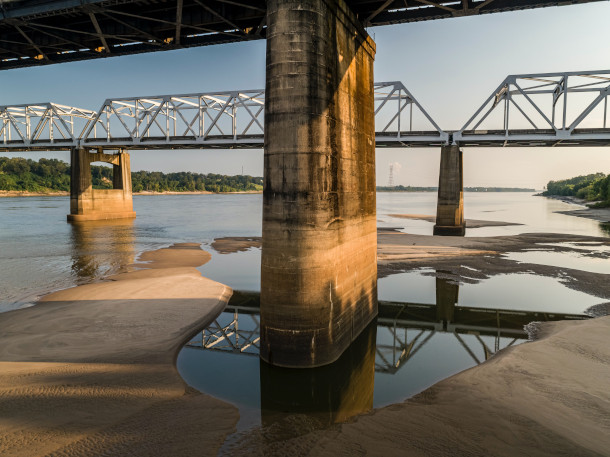
A bridge over the Mississippi reveals how far waters have receded. A shallow river supports less boat traffic, creating an uphill battle for farmers trying to ship their harvests. (Photo: Justin Wilkens on Unsplash)
HART: Well, I think that's the deal. When we're looking at this type of impact from a drought, it isn't just a single year drought. This is because we have seen the drought that has been within the western U.S. has been here for quite some time, but has really started to extend into the Midwest over the last three years. So we are seeing significant multi-year drought impact on the river system, like you say, you know, dropping it to levels we literally have not seen in over 150 years. It's something we really haven't experienced. And it's hard to point to anything other than, you know, climates are changing, we are getting warmer and more extreme within our weather. And that is starting to show up not only in the short run impacts that we're seeing within our weather systems, but in these longer run ramifications of multi-year droughts. Especially here within the Midwest, the most, if you will, consistent signal to tell us how the drought is going to proceed is the El Niño/La Niña cycle. And what we find ourselves in right now is a multi-year La Niña phase and La Niña tends to, if you will, lock in weather patterns across the Midwest here. We're in our third year of that now, the projections are that La Niña will last through the winter. But we may return to what's called neutral conditions by next spring.
CURWOOD: Yeah, and yet La Niña, the three year persistence is–I don't know if it's completely unprecedented, but it's certainly very rare.
HART: It's, well, it's somewhat rare. We've seen... If you go back into the data, we we had a stretch in the early 1970s where we saw this but we didn't have as significant a drought or longer term drought as we did now. We had another period in the 50s, but the one that I'd say most people think is, if you will, the parallel to this one would be the Dust Bowl era that we saw in the 1930s.
CURWOOD: Wait a second, a hair just went up on the back of my neck. We could be looking at a new dust bowl, I hear you suggesting?
HART: No, I wouldn't say that. But the idea is that when you think about the Dust Bowl and the drought that we saw with that it was related to a three to four year La Niña cycle back then as well. I think the big differences here are, when we think about the Dust Bowl era versus today, we have changed our agricultural production systems greatly since then. And so we're not seeing the production impacts like we saw back from the 1930s. We have changed how we produce, what we produce, and those changes have been to the benefit of our production within a drought system. At the same time, too, though, the weather pattern itself is similar to what we saw during the Dust Bowl era.
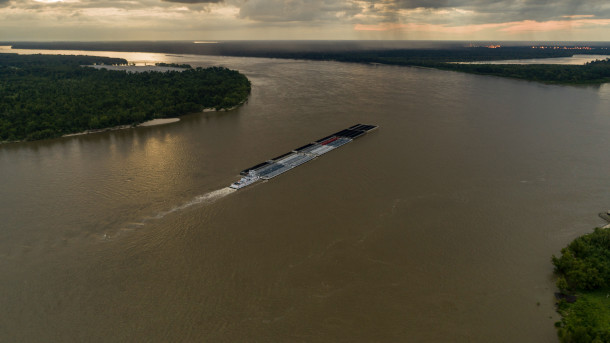
A boat pushes barges upriver. Transportation difficulties are predicted to raise the price of goods manufactured with wheat, corn, and other Midwestern crops in areas distant from where the crops are grown. (Photo: Justin Wilkens on Unsplash)
CURWOOD: And so what's spooky is that in 1928 or so there were these massive floods on the Mississippi followed by the Dust Bowl. And what, two, three, four years ago, we had massive flooding on the Mississippi and now this massive drying.
HART: Yeah, and–well, I think that points out though, that's why I would say you still see discussion about "Is this truly from climate change or not?" is because we have seen periods like this in the past. But we typically have to go back 80, 90, 100 years in order to find those closest parallels as we look out there. But I think what is more concerning is, as you say, the frequency that we do see more extreme weather events seems to be becoming greater as we look at our most recent weather patterns compared to the historical.
CURWOOD: With the long-term drought really affecting the Mississippi, how does this change the agriculture business? You know, people usually plan on the basis of projecting from the past. But now the past may not be such a great guide as we go into this relatively uncharted climate territory. I bet 10 years ago, you wouldn't have...we wouldn't have been talking about the Mississippi running fairly dry.
HART: We probably wouldn't. At the same time, too is, it probably will not change in the short run, at least, what farmers are planting or how they plant it. But I think it does bring up this issue of looking at not only the production risk–so this idea of that we normally think of droughts impacting as you say, the production of the crop, how big the crop is, what the yield is for that farmer. What this shows is that weather has other indirect impacts on the farmers' decision. It's no longer just a worry about the production impacts of a drought, but now you've got to look at–let's call it the marketing/financial burden of a drought that can happen here. Because what's happening with the Mississippi hasn't truly impacted their ability to produce, but it is impacting the farmers' ability to market their crop and receive a price strong enough to cover the cost of their production.
CURWOOD: Chad Hart is a professor of Agricultural Economics at Iowa State University in Ames. Professor, thanks so much for taking the time with us today.
HART: Thank you very much, sir.
Related links:
- Sign up for a webinar about current conditions on the river and the plan moving forward here:
- NOAA’s latest monthly climate report
- Read more about how the Mississippi River drought is affecting the grain industry here:
- Follow the link to learn more about how drought impacts agriculture:
[MUSIC: Larkin Poe, “Mississippi” on Venom & Faith, Tricki-Woo Records]
BASCOMB: Coming up – A lot of Environmental voters are turning out for early voting in Georgia’s runoff Senate election. That’s just ahead on Living on Earth.
ANNOUNCER: Funding for Living on Earth comes from you, our listeners, and United Technologies, combining passion for science with engineering to create solutions designed for sustainability in aerospace, building industries, and food refrigeration.
[CUTAWAY MUSIC: Lafayette Leake, “Easy Blues” on Easy Blues (France, 1978) [Blues Reference], Disques Black & Blue]
Beyond the Headlines
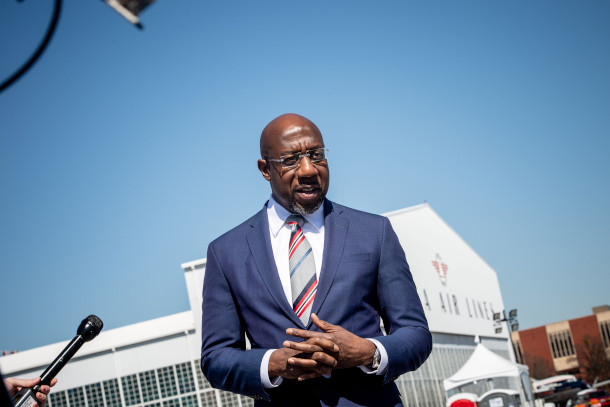
Raphael Gamaliel Warnock is an American minister and politician serving as the junior United States senator from Georgia since 2021. He is running for reelection as the Democratic candidate for the 2022 Georgia elections. (Photo: Delta News Hub, Flickr, CC BY 2.0)
CURWOOD: And I’m Steve Curwood
And on the line with me now from Atlanta, Georgia is Peter Dykstra. Peter is an editor with Environmental Health News that's ehn.org and dailyclimate.org. And hey there, Peter, how are you doing with all those political ads and stuff going on there? The elections over for the rest of us here in the United States, but you've got a hot one right now, huh?
DYKSTRA: That's right, Steve, all over here to except for one race. The last seat in the United States Senate is in a runoff. The election is December 6th. The Democrat incumbent is the Reverend Raphael Warnock. His Republican challenger is the football legend Herschel Walker. They're neck and neck as they were in the general election. We're waiting to see how the runoff works out.
CURWOOD: So there's early voting in Georgian and I understand you've seen some numbers about some of those early voters.
DYKSTRA: Yeah, the Environmental Voter Project took a survey of some of the early voters in the first days down here of early voting. What they call super environmentalists, people who rank the environment and climate change as their most important issue, came to over 20% of early voters. That has to hearten the Democrats who tend to draw the super environmentalist votes and maybe discouraged the Republicans.
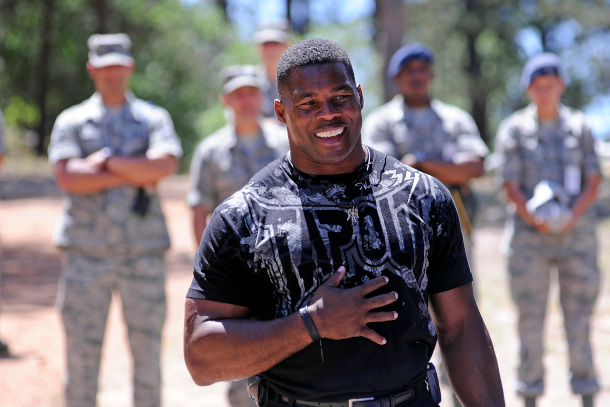
Herschel Junior Walker is an American former football running back and the Republican nominee in the 2022 United States Senate election in Georgia. (Photo: Michael Kaplan, Flickr, CC BY 2.0)
CURWOOD: Hey, what else do you have for us today?
DYKSTRA: Well, there's a 26-storey brand spanking new building in Hubei province in China. It's a skyscraper not for people, not for rich folks, not for middle class folks, but it's for pigs. That's 26-storey vertical operation can handle as many as 30,000 pigs a day. It has six large elevators that can move hundreds of pigs from floor to floor at a time. And I can't imagine a vertical slaughterhouse in an urban area is gonna smell very nice.
CURWOOD: It doesn't sound like it's really great for the hogs. I mean, in other words, I suspect there'll be born in that building, and eventually killed in that building with never having been outside and never, never doing what pigs like to do, which is wallow.
DYKSTRA: But they can still stink and they can still spread disease. And in an area with a heavy concentration of humans, having just gone through a horrible pandemic, that's got to be a big concern as well.
China’s 26-storey pig skyscraper ready to slaughter 1 million pigs a year https://t.co/8ti7q9f49W
— The Guardian (@guardian) November 25, 2022
CURWOOD: Yeah, I'm thinking of the swine flu that we've had come and go over the years, it can't help that.
DYKSTRA: Not at all.
CURWOOD: Hey, Peter let's turn out to the annals of history and tell me what you see or smell maybe since we've been talking about those hogs.
DYKSTRA: Well, I guess this is a smelly one, but it certainly hurts the respiratory system, and it did on December 7th, 1873, when a killer fog descended on London. This is the time of year when those notorious London fogs blanket the city as coal use increased, there were coal stoves and just about every home. Those killer fogs included a lot of pollution. In 1873, about 1,000 people are said to have died over the next week. The fog eventually lifted, but many other killer fogs followed in subsequent years. One of the worst was in the first week in December in 1952, when an estimated 4,000 people choked on London's smog fog that also included particulates from diesel buses and diesel trucks, those individual home coal stoves, and coal burning electric power plants. It was a mess that eventually led to some changes.
CURWOOD: So what did the Brits do about this?
DYKSTRA: They actually had a Clean Air Act before the US had a Clean Air Act. It took four years but in 1956, the British or the UK Clean Air Act came into effect, cleaning up some of the urban uses of coal, which eventually began to decline of its own accord and decline over our current concern on climate change.
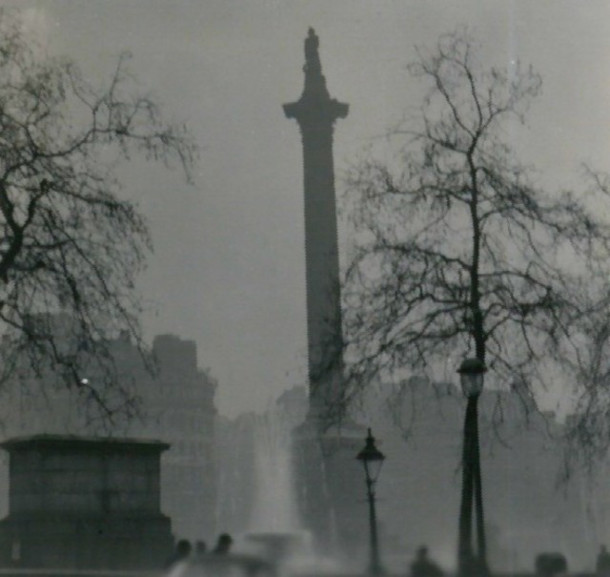
Nelson's Column a monument in Trafalgar Square in the City of Westminster, Central London during the Great Smog of 1952. (Photo: N.T. Stobbs, Wikimedia Commons, CC BY-SA 2.0)
CURWOOD: Well, thanks, Peter. Peter Dykstra is an editor with Environmental Health News, that's ehn.org and dailyclimate.org. And we'll talk to you again real soon.
DYKSTRA: All right, Steve, thanks a lot. Talk to you soon.
CURWOOD: And there's more on the stories on the Living on Earth webpage that's loe.org.
Related links:
- Follow the Georgia Runoff elections
- Learn more about the Environmental Voter Project
- Le Monde | “26 Stories of Swine: World's Largest Pig Farm Opens in China”
- Learn more about the Great Smog of 1952
[MUSIC: The Beatles, “While My Guitar Gently Weeps” on The Beatles (Remastered), Apple Corps]
Battle For the Sepik River
A family travel home by boat from fishing at the Lower Sepik River in Angoram District, Papua New Guinea. (Photo: Courtesy of Troy Mabos, Project Sepik)
BASCOMB: The island of Papua New Guinea in the South Pacific is one of the most biologically diverse places in the world. It’s home to blue-eyed cockatoos, tree kangaroos, and hundreds of other species found nowhere else on earth. The island is also the home to hundreds of indigenous forest communities; many of whom live along the Sepik River, the longest river in New Guinea. These communities rely on the river for their very sustenance but a proposed copper and gold mine has people of the region concerned for their own lives and the health of their environment. So, they’ve formed Project Sepik, an environmental group fighting to stop the mine before it gets started. For more I’m joined now by Manu Peni, the coordinator of Project Sepik. Welcome to Living on Earth, Manu.
PENI: Thank you, it's a pleasure to be with your team.
BASCOMB: Now, the Sepik River is the longest river in Papua New Guinea. How important is it for the indigenous communities that live along that river?
PENI: The Sepik River is the longest river and it's one of the most intact and freshwater ecosystem in the South Pacific region. So we would like to also see that as an iconic river of the South Pacific or Asia Pacific. It's really important for us right now. It sustains our livelihood, it's our life is so different from the lives in New York, in Australia, in Paris, or in Amsterdam. We basically live off the river and our identity, our cultural totems, marks and our cultural activities, even at the spiritual level to are all intertwined with this river.
BASCOMB: Now there is a mine planned for the area, a copper and gold mine run by a company named Panaust, that's a Chinese company based in Australia. What concerns you most about that proposed mine?
PENI: Our concerns, the people's concern, that history in Papua New Guinea in mining and logging has shown that communities do not benefit at all. It's usually the environment gets destroyed, people get exploited, the companies just leave. For example, the Ok Tedi, which was mined by BHP, an Australian-based company, this river is now dead. The government has made a law, two thirds of the parliament voted that the people after 30-40 years when they start experiencing, you know, health issues, because of the heavy metals, they cannot take the company or the government to court. So that's how exploitative and destructive experiences of the mine is. The mine still works today in Ok Tedi and they just openly dump everything into the river, so the river is dead. For the Sepik River, it's more concerning because the planned mine site, it sits on the rim of fire, meaning it's one of the most seismically active places in the world. In fact, we experienced an earthquake measuring 7.8 on the Richter scale not too far from the mine. So every day, there is seismic activity. Also the soil morphology of that area, it's got very high rainfall. It's not a place, according to several scientists, that a mine should be built.
An egret photographed in a lake at Korogu Village, located near the Sepik River, in Papua New Guinea. (Photo: Courtesy of Shayenne Waide, Project Sepik)
BASCOMB: Yeah, well, it's easy to see how a mine situated in a seismically-active area prone to earthquakes is potentially dangerous. What are some of the potential consequences do you think for wildlife and the water supply and, you know, the people that make their living from an intact environment there?
PENI: The 400,000 people that live along the river or that's connected to the river, their life depends entirely on the safety of that ecosystem right out to the, to the delta. So these are our concern. Today, when you go it looks like chocolate, the water is, you know, it's got silts, but people just drink from it. If that was to go, then the people will have no other water source. Because, I mean, if they step away from the river, they go into the lakes and the swamp marshes. So where will they go to get water? And where will they build their house? And where will they collect food or materials to build a house. That's the only source of life for them. It's their livelihood.
BASCOMB: And generally, when companies are looking to go into a place like this and mine or extract any kind of resources, they're required to get a free prior informed consent, meaning the people that live there have to know what's happening and say, "Yes, this is okay for us." What happened with your community when it comes to that free prior informed consent?
Young men dress in traditional costume before performing Val’ra Sum dance, or a dance to celebrate canoe, during the 2022 N’gusunga Celebration in Korogu Village, Papua New Guinea. (Photo: Courtesy of Troy Mabos, Project Sepik)
PENI: The mining community comes with soldiers, with policemen with automatic rifles stand there. And they only talk about what the mine will give to the community, will give them electricity, will give them roads, schools and hospitals. And this was the same conversation, the same kind of communication that communities across Papua New Guinea have heard from logging and mining companies. And so they say that they don't even say that it's sitting on a seismically-active place in the world. They don't say that "We will build a dam and change your life because the water will sort of stop flowing." They don't say that the chances of the dam breaking. And that's also something that they didn't include in the EIS, the environmental impact statement, when they submitted to the government for the permit, the environmental permit. They excluded the dam break analysis and we've been asking for it as an organization. So it's the way in which they go in to do free prior and informed consent. So recently, we made a complaint to the OECD, the Organization for Economic Cooperation and Development, about standards and regulations set by OECD that the mining company wasn't following, especially on FPIC. And so I think as a reaction, they, they came back to the villages. And this was what they were saying: "Please say yes to the mine, but no to the dam." I mean, it's just, and we understand where they're going because they're trying to build deep sea tailings placement. It's river-end tailings, meaning they dump all the waste under the ocean floor. And that particular technique or way of disposal of the waste, is actually banned in Canada, banned in New Zealand and banned in Australia. So a question is, how is it that the same science, the science that justifies everything, says it's okay to build this thing in Papua New Guinea, but it's not okay to build it in Canada, Australia, New Zealand and elsewhere? The contradictions are so loud and so visible. And yeah, we could hear it from afar.
BASCOMB: Yeah, I mean, turning up to a community with soldiers and guns, saying "This is good for you, sign here," doesn't sound too free. And I understand that you've organized a fight this mine. What does that look like? How are you going about pushing back against the proposed project there?
PENI: So in 2016, we started this work. And it broke my heart because I went to the village and heard that people were just like, "We can't do anything. There's nothing we can do. It's the government and they've got this and they've got that and we can't fight against the government." So in 2017, funded from Norway, Rainforest Network, they asked me, "Are you going to stop the mine?" And I said, "No, I can't stop the mine. I'm fighting against Australia. I'm fighting against my own government, Papua New Guinea. I'm fighting against the Chinese Communist Party. And I'm fighting against the mine. But I can promise you, I can delay them." And while we delay them, we look at other tactics in terms of ensuring that they follow rules and regulations and standards. So as a collaborative team in our campaign called Save the Sepik, we've been able to delay the government to give the environmental permit to the company after it submitted their environmental impact statement. This was done in 2018. And we're still waiting for the results from the government. So we were able to do that. But the new government formed last August and already noises about starting the mining and handling the environmental permit. So our work gets even more important. The communities from the headwaters on the Frieda River, the way the mine will be based and is one of the major tributary to the Sepik River, all the communities from the all the way down to the delta are overwhelmingly supporting us. Every one of them has signed numerous documents, declarations and petitions and numerous protests they've signed and have also been able to threaten the government from going on to their land. We know what you're going to say already.
Emmanuel “Manu” Peni, coordinator of Project Sepik, a non-profit organization that advocates the interest of indigenous communities along Sepik River in Papua New Guinea. (Photo: Courtesy of Troy Mabos, Project Sepik)
BASCOMB: And I understand that you've actually had threats against your life as a result of your activism. Can you tell us about that, please?
PENI: In 2018, I went for a visit just along the river, just so that I reconnect to my people and connections so that we can start the campaign. I got carjacked. And I thought it was just a random thing. And then second time within, within the space of a couple of days, my mother who was about 80 years old, and my son was seven years old, were in the car when we got there. We're going to carjack and then we, I drove off and they shot at us with guns.
BASCOMB: Why do you keep at this work? I mean, what keeps you motivated and working on this despite the threats to your life and threats to your family and you know, the uphill battle of fighting a multinational company and your own government?
PENI: Ever since I left university in New Zealand and went back home, I've always been part of social and justice movements in my country, because I can see injustice at all levels of society. I don't just see, I feel it too. I feel it because that's my home I grew up in. I know I can feel when people are hungry, I can feel when people are hurt. Because I came from a single parent. My mother looked, I'm on my, I am my mother's child. And I grew up in a squatter settlement. I know what it's like to be poor. I know what it's like to face injustice of different sorts. And that's why I couldn't just, and with my knowledge, experience and skills, I couldn't just stand there and watch while outsiders come in and take control of my government, pay off officials, pay off policemen to go down and exploit my people and destroy our river and our source of life, our source of identity and our heritage. I couldn't do it. I'd rather be killed doing this then go elsewhere and live in Australia or New Zealand, sip of wine and hear stories from home. I just couldn't do it. And I think it's me living a meaningful life in this life in this present journey on Earth.
BASCOMB: Manu Peni is coordinator of Project Sepik in Papua New Guinea. Manu, thank you so much for taking the time with me today and for all of your hard work there.
PENI: Thank you for having me on on your podcast and thank you to your team.
Related links:
- Click here to visit the website of Save the Sepik, the collaboration campaign to protect the Sepik River from the planned Frieda River Mine
- Mongabay | “Proposed Copper and Gold Mine Threatens the World’s ‘Second Amazon’ in PNG”
- Read the excerpt of Peni’s TED talk here
- The Guardian | “Mining in the Pacific: A Blessing and A Curse”
[MUSIC: O-Shen, Typical Hawaiians, Thomson Enos, “Waiting for You” on Th Reggae Hui Compilation “Island Vibrations,” Vol. 1, THP]
Listening on Earth
[KIDS CHEERING]
CURWOOD: The World Cup soccer games are in full swing in Qatar and around the world fans are tuning in to cheer on their country’s team.
[KIDS CHEERING]
CURWOOD: At the Cloud Forest School in Monteverde, Costa Rica school stopped mid-morning so students could watch Costa Rica play Spain.
[KIDS CHEERING]
[MUSIC: Federico Miranda “Tutuno Mama” on Baula Project: Corazones al Mar, Baula Producciones S.D.R.L.]
CURWOOD: Living on Earth is produced by the World Media Foundation.
Our crew includes Fern Alling, Naomi Arenberg, Paloma Beltran, Chloe Chen, Iris Chen, Josh Croom, Jenni Doering, Mark Kausch, Kharishar Kahfi, Mark Seth Lender, Don Lyman, Louis Mallison, Aynsley O’Neill, Sophia Pandelidis, Jake Rego, Ashley Soebroto, and Jolanda Omari.
BASCOMB: Tom Tiger engineered our show. Alison Lirish Dean composed our themes. You can hear us anytime at loe.org, Apple Podcasts and Google Podcasts, and like us, please, on our Facebook page - Living on Earth. We tweet from @livingonearth. And find us on Instagram at livingonearthradio. I’m Bobby Bascomb.
CURWOOD: And I’m Steve Curwood. Thanks for listening!
ANNOUNCER: Funding for Living on Earth comes from you, our listeners, and from the University of Massachusetts, Boston, in association with its School for the Environment, developing the next generation of environmental leaders. And from the Grantham Foundation for the protection of the environment, supporting strategic communications and collaboration in solving the world’s most pressing environmental problems.
ANNOUNCER 2: PRX.
Living on Earth wants to hear from you!
Living on Earth
62 Calef Highway, Suite 212
Lee, NH 03861
Telephone: 617-287-4121
E-mail: comments@loe.org
Newsletter [Click here]
Donate to Living on Earth!
Living on Earth is an independent media program and relies entirely on contributions from listeners and institutions supporting public service. Please donate now to preserve an independent environmental voice.
NewsletterLiving on Earth offers a weekly delivery of the show's rundown to your mailbox. Sign up for our newsletter today!
 Sailors For The Sea: Be the change you want to sea.
Sailors For The Sea: Be the change you want to sea.
 The Grantham Foundation for the Protection of the Environment: Committed to protecting and improving the health of the global environment.
The Grantham Foundation for the Protection of the Environment: Committed to protecting and improving the health of the global environment.
 Contribute to Living on Earth and receive, as our gift to you, an archival print of one of Mark Seth Lender's extraordinary wildlife photographs. Follow the link to see Mark's current collection of photographs.
Contribute to Living on Earth and receive, as our gift to you, an archival print of one of Mark Seth Lender's extraordinary wildlife photographs. Follow the link to see Mark's current collection of photographs.
 Buy a signed copy of Mark Seth Lender's book Smeagull the Seagull & support Living on Earth
Buy a signed copy of Mark Seth Lender's book Smeagull the Seagull & support Living on Earth

